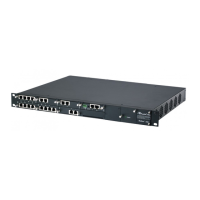User's Manual 372 Document #: LTRT-10532
Mediant 500L Gateway & E-SBC
Parameter Description
addition, it defines how the device saves registrations’ information for
REGISTER messages received from the IP Group, in its registration
database. For requests routed to the IP Group's users, the device replaces
the Request-URI header with the incoming To header (which contains the
remote phone number).
[0] No = (Default) No extra key based on source IP address is added to
the registration database.
[1] Classify by IP = For initial registrations from the IP Group, the device
adds a key representing the user to its registration database, based on
the REGISTER request source IP address, port (if UDP) and SIP
Interface ID (e.g., "10.33.3.3:5010#1"). The device classifies incoming
non-REGISTER SIP dialog requests (e.g., INVITEs) from the IP Group
according to the received source IP address. The device rejects initial
registration requests that have the same IP address, as the necessary
key is already used for another registration.
[2] Classify by IP and Contact = For initial registrations from the IP
Group, the device adds a key representing the user to its registration
database, based on the URI of the Contact header, source IP address,
port (if UDP) and SIP Interface ID (e.g.,
"user@host.com#10.33.3.3:5010#1"). The device classifies incoming
non-REGISTER SIP dialog requests (e.g., INVITEs) from the IP Group
according to the received IP address and Contact URI. The device
rejects initial registration requests that have the same IP address and
Contact URI, as the necessary key is already used for another
registration.
Note:
The parameter is applicable only to User-type IP Groups.
The parameter is applicable only to the SBC application.
SBC PSAP Mode
sbc-psap-mode
[IPGroup_SBCPSAPMo
de]
Enables E9-1-1 emergency call routing in a Microsoft Skype for Business
environment.
[0] Disable (default)
[1] Enable
For more information, see E9-1-1 Support for Microsoft Skype for Business
on page 302.
Route Using Request
URI Port
use-requri-port
[IPGroup_SBCRouteUsi
ngRequestURIPort]
Enables the device to use the port indicated in the Request-URI of the
incoming message as the destination port when routing the message to the
IP Group. The device uses the IP address (and not port) that is configured
for the Proxy Set associated with the IP Group. The parameter thus allows
the device to route calls to the same server (IP Group), but different port.
[0] Disable = (Default) The port configured for the associated Proxy Set
is used as the destination port.
[1] Enable = The port indicated in the Request-URI of the incoming
message is used as the destination port.
DTLS Context
dtls-context
[IPGroup_DTLSContext
]
Assigns a TLS Context (certificate) to the IP Group, which is used for DTLS
sessions (handshakes) with the IP Group.
By default, no value is defined.
To configure TLS Contexts, see Configuring TLS Certificate Contexts on
page 113.
Keep Original Call-ID
sbc-keep-call-id
Enables the device to use the same call identification (SIP Call-ID header
value) received in incoming messages for the call identification in outgoing
messages. The call identification value is contained in the SIP Call-ID

